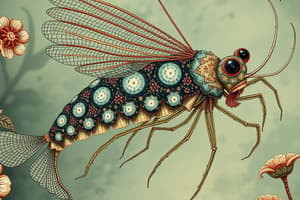Podcast
Questions and Answers
What types of animals are branchiopoda?
What types of animals are branchiopoda?
Brine shrimps and fairy shrimps.
What type of environment does most branchiopoda live in?
What type of environment does most branchiopoda live in?
Mostly freshwater.
What body part of branchiopods are used for respiration and swimming?
What body part of branchiopods are used for respiration and swimming?
The thoracic coxa is enlarged and flattened for swimming and respiration.
The body of branchiopods is covered by _____; only which branchiopod has it?
The body of branchiopods is covered by _____; only which branchiopod has it?
What do branchiopods have for seeing?
What do branchiopods have for seeing?
What do branchiopoda eat, and how are they important to other animals?
What do branchiopoda eat, and how are they important to other animals?
What traits and characteristics do branchiopoda have that allow them to live in saline or ephemeral environments?
What traits and characteristics do branchiopoda have that allow them to live in saline or ephemeral environments?
What are zooplankton?
What are zooplankton?
What are phytoplankton?
What are phytoplankton?
Flashcards are hidden until you start studying
Study Notes
Branchiopoda Overview
- Branchiopoda includes animals like brine shrimps and fairy shrimps.
- Primarily inhabit freshwater environments.
Morphological Features
- Enlarged and flattened thoracic coxa aid in respiration and swimming.
- Bodies are often covered by a bivalve carapace; only fairy shrimps possess this feature, while brine shrimps do not.
Sensory Structures
- Possess compound eyes; some species have a fused pair of compound eyes for enhanced vision.
Ecological Role
- Serve as a crucial component of zooplankton, primarily feeding on algae.
- Act as an important food source for many aquatic animals.
Adaptations
- Possess desiccation-resistant eggs, enabling survival in saline or ephemeral habitats.
- Exhibit high salt-tolerance, allowing habitation in diverse environments.
Zooplankton and Phytoplankton
- Zooplankton are small animals that drift in water and consume phytoplankton.
- Phytoplankton refers to photosynthetic organisms that also drift in aquatic environments, forming the base of the aquatic food web.
Studying That Suits You
Use AI to generate personalized quizzes and flashcards to suit your learning preferences.




